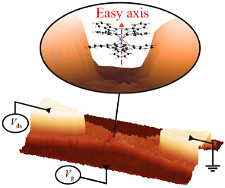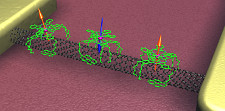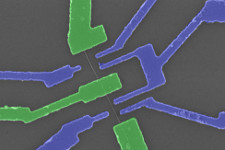Molecular quantum spintronics
The realization of an operational quantum computer is one of the most ambitious technologically goals of today’s scientists. In this regard, the basic building block is generally composed of a two-level quantum system, namely a quantum bit (or qubit). Such quantum system must be fully controllable and measurable, which requires a connection to the macroscopic world. In this context, solid state devices, which establish electrical interconnections to the qubit, are of high interest, mainly due to the variety of methods available for fabrication of complex and scalable architectures. Moreover, outstanding improvements in the control of the qubit dynamics have been achieved in the last years. Among the different solid state concepts, spin based devices are very attractive since they already exhibit relatively long coherence times. For this reason, electrons possessing a spin 1/2 are conventionally thought as the natural carriers of quantum information. However, the strong coupling to the environment makes it extremely difficult to maintain a stable entanglement. Alternative concepts propose the use of nuclear spins as building blocks for quantum computing, since they benefit from longer coherence times compared to electronic spins, because of a better isolation from the environment. But weak coupling comes at a price: the detection and manipulation of individual nuclear spins remain difficult tasks.
 |

|
 |
| a | b | c |
|
Fig.: (a) Molecular spin-transistor in which electron transport can be controlled by an electrostatic coupling to a gate voltage. A schematic zoom into the nano gap is depicted on the upper part showing the molecular structure of the TbPc2-SMM (Pc = phthalocyanine) as well as its easy axis. (b) A spin-valve built entirely from soft organic materials rather than the usual inorganics: A lead made of a single-wall carbon nanotube (black in the Figure) is contacted at each end by non-magnetic electrodes (gold colour). The devise is coupled laterally to TbPc2 quantum magnets (green). Sweeping a magnetic field modulates the conductance through the nanotube, achieving magnetoresistance ratios up to 300% between fully polarized and non-polarized molecular configurations. (c) First realization of a multigate device. The carbon nanotube is connected to three electrodes (green). Several local gates (blue) allow the tuning of the coupling between the nanotube and the SMMs deposited onto the nanotube. |
||
In this context, in collaboration with Institut Néel, NanoSpin, our main objective is to lay the foundation of a new field, combining the disciplines, spintronics, molecular electronics, and quantum information processing. In particular, the objective is to fabricate, characterize and study molecular devices (molecular spin-transistor, molecular spin-valve and spin filter, molecular double-dot devices, carbon nanotube nano-SQUIDs, etc.) in order to read and manipulate the spin states of the molecule and to perform basic quantum operations.
Our project is designed to play a role of pathfinder in this –still largely unexplored - field. The main target concerned fundamental science, but applications in quantum electronics are expected in the long run.
References:
Bogani, L. & Wernsdorfer, W.
Molecular spintronics using single-molecule magnets
Nature Materials, 2008, 7, 179-186

